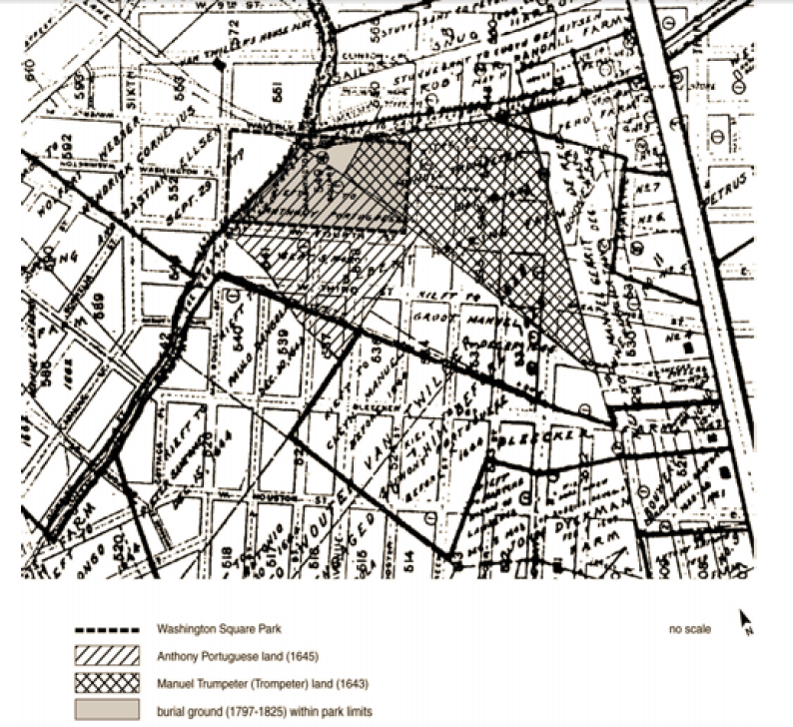Do You Know Anthony Portugese?
In September 1645, a man named Anthony Portuguese was granted farmland that today is part of Washington Square Park. But if you’re picturing a white Dutchman, think again. Anthony was part of a group of black men given similar land grants. Hovering somewhere between slavery and freedom, these men eked out a difficult living on the edge of the Dutch Colony that would eventually grow into New York City.
Over 200 years ago, the land that would one day be familiar to us as Washington Square Park was part of New Amsterdam. Where you’ll now find daffodils and cherry blossoms blooming were once fields of farmland. But the land wasn’t tended by Dutch colonists or European farmers. It was worked by two men named Anthony Portuguese and Manuel Trumpeter; and they were half-freed slaves.
When Manahatta (the Lenape name for the island of Manhattan) was first settled as New Amsterdam in 1626 by the Dutch West India Company, enslaved black people played a large role in Colony life. By the early and mid-1640s, Willem Kieft, the fifth Director of New Netherland and Director of the West India Company, began granting conditional freedom to some of the men the Company enslaved. They were given plots of land to farm and live on, enough to sustain themselves and their families as well as produce for the Company. Manuel Trumpeter and Anthony Portugese were just two of the men freed and given land, and their grants included parts of what later became Washington Square Park. In addition to the crops provided for the Dutch settlement, these land grants helped create a buffer zone between the colony and the native Lenape tribes during a time of war.
Thanks to records surviving from the colony, city, and church, we’re able to get a glimpse of what the lives of these “half-freed” slaves were like. An article by Peter R. Christoph, The Freedmen of New Amsterdam explores what days were like in the colony under Dutch rule. In a particularly telling anecdote, in 1638 Anthony Portuguese sued a white merchant for injury to his hog. This minor legal squabble is the perfect example of how half-freed slaves of the Company like Portuguese differed from those enslaved later in the history of the United States. He was allowed to own property, and had redress in court, rights that slaves living in British New York would never have had. Along with these rights, half-freed individuals in New Amsterdam were permitted to marry, to inherit property, to be baptized, and to be paid for work done outside of Company time. They were even given weapons and asked to help in the Colony’s fight against the natives.
Despite their freed status and land ownership, however, these men were, in reality, still enslaved. Their freedom was not absolute and very tenuous. They were required to give a number of crops and animals from their farmland back to the Colony each year. The West India Company reserved the right to call them into service at any time, although they would be paid for the work. Perhaps most significantly, while men could purchase the freedom of their loved ones (provided they could afford it) their conditional freedom did not automatically extend to their spouses and children.
While we have historical documents to give us a glimpse at life back then, they do not provide the thought processes behind the decisions the Company made regarding those it enslaved. The Colony’s food needs likely played a large role in the decision to disburse land grants, as at this time it was a Company town dominated by fur trade, not farmers. It may have also been a way to keep laborers docile and happy. Safety may have also been a factor. In the 1600s, the main part of the city was growing at the tip of Manhattan, which put the land grants pretty far on the outskirts of town. They would have provided a buffer between the hostile natives and the Colony proper.
We will never have a complete picture of what the lives of Trumpeter, Portuguese, and the other men like them truly were. But these glimpses into the past do show us that there is plenty to ruminate on as we imagine what life was like for those who farmed the land on and around what is now Washington Square Park.


